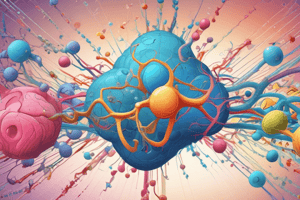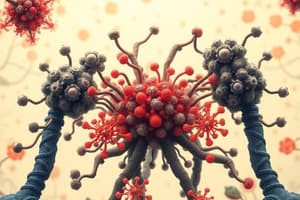Podcast
Questions and Answers
What is the primary action of the activated αs-subunit in Gs-coupled receptors?
What is the primary action of the activated αs-subunit in Gs-coupled receptors?
- Activation of adenylyl cyclase (correct)
- Conversion of cAMP to ATP
- Increased Ca²⁺ release from the endoplasmic reticulum
- Inhibition of phospholipase C
Which of the following correctly describes the outcome of reduced cAMP in cells with Gi-coupled receptors?
Which of the following correctly describes the outcome of reduced cAMP in cells with Gi-coupled receptors?
- Enhanced release of neurotransmitters
- Increased muscle contraction
- Stimulated adenylyl cyclase activity
- Decreased PKA activity (correct)
What is the role of IP3 in the Gq-coupled receptor mechanism?
What is the role of IP3 in the Gq-coupled receptor mechanism?
- Releases Ca²⁺ from the endoplasmic reticulum (correct)
- Stimulates cAMP production
- Inhibits PKA activation
- Activates adenylyl cyclase
Which receptor is associated with the action of adrenaline and noradrenaline through Gs-coupled mechanisms?
Which receptor is associated with the action of adrenaline and noradrenaline through Gs-coupled mechanisms?
What response is most likely mediated by PKC activation in Gq-coupled receptors?
What response is most likely mediated by PKC activation in Gq-coupled receptors?
Flashcards
GsPCR Mechanism
GsPCR Mechanism
Ligand activates Gs protein, which activates adenylyl cyclase, producing cAMP, activating PKA for downstream effects.
GiPCR Mechanism
GiPCR Mechanism
Ligand activates Gi protein, inhibiting adenylyl cyclase, reducing cAMP and PKA activity.
GqPCR Mechanism
GqPCR Mechanism
Ligand activates Gq protein, activating PLC, breaking down PIP2 into IP3 and DAG, stimulating Ca²⁺ release and PKC activation.
Gs-coupled receptor examples
Gs-coupled receptor examples
Signup and view all the flashcards
Gq-coupled receptor examples
Gq-coupled receptor examples
Signup and view all the flashcards
Study Notes
Gs-PCR Mechanism
- Ligand binding (e.g., adrenaline to β-adrenergic receptor) activates the Gs-coupled receptor.
- G protein (αs-subunit) exchanges GDP for GTP, becoming activated.
- Activated αs-subunit stimulates adenylyl cyclase.
- Adenylyl cyclase converts ATP to cAMP.
- cAMP activates protein kinase A (PKA).
- PKA triggers downstream effects (e.g., glycogen breakdown, smooth muscle relaxation).
Gi-PCR Mechanism
- Ligand binding (e.g., acetylcholine to muscarinic M2 receptor) activates the Gi-coupled receptor.
- G protein (αi-subunit) exchanges GDP for GTP, becoming activated.
- Activated αi-subunit inhibits adenylyl cyclase.
- Decreased adenylyl cyclase activity reduces cAMP production.
- Reduced cAMP leads to decreased PKA activity.
- Altered cellular responses result from changes in cAMP and PKA.
Gq-PCR Mechanism (IP₃ and DAG Pathway)
- Ligand binding (e.g., acetylcholine to muscarinic M3 receptor) activates the Gq-coupled receptor.
- G protein (αq-subunit) exchanges GDP for GTP, becoming activated.
- Activated αq-subunit stimulates phospholipase C (PLC).
- PLC cleaves phosphatidylinositol 4,5-bisphosphate (PIP₂) into:
- IP₃: Binds to IP₃ receptors on the endoplasmic reticulum, releasing calcium ions (Ca²⁺).
- DAG: Activates protein kinase C (PKC), which phosphorylates target proteins.
- Increased calcium ions (Ca²⁺) and PKC activity cause various cellular responses (e.g., muscle contraction, secretion).
Gs-Coupled Receptor Examples
- β-adrenergic receptors (β1, β2, β3): Respond to adrenaline and noradrenaline.
- Dopamine D1 receptors.
- Histamine H2 receptors.
Gi-Coupled Receptor Examples
- α2-adrenergic receptors: Inhibit norepinephrine release.
- Dopamine D2 receptors.
- Opioid receptors (μ, κ, δ): Mediate pain relief and other effects.
Gq-Coupled Receptor Examples
- α1-adrenergic receptors: Mediate smooth muscle contraction.
- Muscarinic M1 and M3 receptors.
- Histamine H1 receptors.
Studying That Suits You
Use AI to generate personalized quizzes and flashcards to suit your learning preferences.




